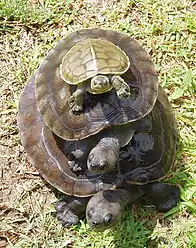Yellow pond turtle
The yellow pond turtle (Mauremys mutica), is a medium-sized (to 19.5 cm), semi-aquatic turtle in the family Geoemydidae. This species has a characteristic broad yellow stripe extending behind the eye and down the neck; the carapace ranges in color from grayish brown to brown and the plastron is yellow or orange with black blotches along the outer edges.[2] It is found in East Asia, ranging from central Vietnam, north through the coastal provinces of south and central China. Additional insular populations are found in Taiwan, Hainan, the Ryukyu Islands, and Japan.[3] The Japanese populations are believed to have been introduced as a result of imports from Taiwan.[4]
| Yellow pond turtle | |
|---|---|
 | |
| Stuffed specimen of Mauremys mutica kami, exhibited in the National Museum of Nature and Science, Tokyo, Japan. | |
| Scientific classification | |
| Kingdom: | Animalia |
| Phylum: | Chordata |
| Class: | Reptilia |
| Order: | Testudines |
| Suborder: | Cryptodira |
| Superfamily: | Testudinoidea |
| Family: | Geoemydidae |
| Genus: | Mauremys |
| Species: | M. mutica |
| Binomial name | |
| Mauremys mutica (Cantor, 1842) | |
| Synonyms[1] | |
| |
This species inhabits ponds, creeks, swamps, marshes and other bodies of shallow, slow-moving water. It is omnivorous, feeding on insects, fish, tadpoles, and vegetable matter such as leaves and seeds. The yellow pond turtle generally remains in or close to water during the day but may become more active at night and during rainy weather, when it sometimes ventures onto land.[4]
One subspecies, Mauremys mutica kami, is currently recognized in the Ryukyu Islands.[4] Research has shown unexpected genetic diversity in M. mutica, raising the possibility that additional subspecies might exist. Evidence of widespread hybridization further complicates efforts to understand the genetics of this and related species.[5] Several hybrid Asian pond turtles that were described as new species have been found to be hybrids. Fujian pond turtles (Mauremys iversoni) are hybrid specimens mainly produced in Chinese turtle farms, usually from matings between female yellow pond turtles and golden coin turtles (Cuora trifasciata) males. The supposed Mauremys pritchardi turtles are wild and captive-bred hybrids between the present species and the Chinese pond turtle (Chinemys reevesi).[6][7]
"Clemmys guangxiensis" is a composite taxon described from specimens of Mauremys mutica and the natural hybrid "Mauremys" × iversoni.[7]
The yellow pond turtle is threatened with extinction. China is the largest consumer of turtles in the world and this trade has been cited as the greatest threat to Asian turtles including M. mutica. Most of the turtle trade is destined for human consumption but traditional medicine[8] and the pet trade are also driving demand for turtles.[9][10][11] Habitat loss and water pollution are additional impacts. The IUCN considers M. mutica an endangered species and it is listed in CITES Appendix II.[3]

Notes
- Fritz Uwe; Peter Havaš (2007). "Checklist of Chelonians of the World" (PDF). Vertebrate Zoology. 57 (2): 231–232. ISSN 1864-5755. Archived (PDF) from the original on 2010-12-17. Retrieved 29 May 2012.
- Ernst, Altenburg & Barbour.
- Asian Turtle Trade Working Group (2000).
- Yasukawa, Ota & Iverson (1996).
- Fong et al. (2007).
- Feldman & Parham (2004).
- Parham et al. (2001).
- Rômulo, Washington & Gindomar (2008).
- Cheung & Dudgeon (2006).
- Gong et al. (2009).
- Shi & Parham (2000).
| Wikispecies has information related to Mauremys mutica. |
| Wikimedia Commons has media related to Mauremys mutica. |
References
- Asian Turtle Trade Working Group (2000). "Mauremys mutica". IUCN Red List of Threatened Species. doi:10.2305/IUCN.UK.2000.RLTS.T39613A10251132.en.
- Cheung, S. M.; Dudgeon, D. (2006). "Quantifying the Asian turtle crisis: market surveys in southern China, 2000–2003". Aquatic Conservation: Marine and Freshwater Ecosystems. 16 (7): 751–770. doi:10.1002/aqc.803.
- Ernst, C.H.; Altenburg, R.G.M.; Barbour, R.W. "Mauremys mutica". Turtles of the World. World Biodiversity Database. Archived from the original on 2016-02-23. Retrieved 26 January 2016.
- Feldman, Chris R.; Parham, James F. (2004). "Molecular Systematics of Old World Stripe-Necked Turtles (Testudines: Mauremys)" (PDF). Asiatic Herpetological Research. 10: 28–37.
- Fong, J.J.; Parham, J.F.; Shi, H.; Stuart, B.L.; Carter, R.L. (2007). "A genetic survey of heavily exploited, endangered turtles: caveats on the conservation value of trade animals". Animal Conservation. 10 (4): 452–460. doi:10.1111/j.1469-1795.2007.00131.x.
- Gong, Shi-Pin; Chow, Alex T.; Fong, Jonathan J.; Shi, Hai-Tao (2009). "The chelonian trade in the largest pet market in China: scale, scope and impact on turtle conservation". Oryx. 43 (2): 213–216. doi:10.1017/S0030605308000902.
- Parham, James Ford; Simison, W. Brian; Kozak, Kenneth H.; Feldman, Chris R.; Shi, Haitao (2001). "New Chinese turtles: endangered or invalid? A reassessment of two species using mitochondrial DNA, allozyme electrophoresis and known-locality specimens" (PDF). Animal Conservation. 4 (4): 357–367. doi:10.1017/s1367943001001421.
- Rômulo, Nóbrega Alves; Washington, Silva Vieira; Gindomar, Santana (2008). "Reptiles used in traditional folk medicine: conservation implications". Biodiversity and Conservation. 17 (8): 2037–2049. doi:10.1007/s10531-007-9305-0. S2CID 42500066.
- Shi, Haitao; Parham, James Ford (2000). "Preliminary Observations of a Large Turtle Farm in Hainan Province, People's Republic of China". Turtle and Tortoise Newsletter. 3: 4–6. Retrieved 27 January 2016.
- Yasukawa, Yuichirou; Ota, Hidetoshi; Iverson, John B. (1996). "Geographic Variation and Sexual Size Dimorphism in Mauremys mutica (Cantor, 1842) (Reptilia: Bataguridae), with Description of a New Subspecies from the Southern Ryukyus, Japan" (PDF). Zoological Science. 13 (2): 303–317. doi:10.2108/zsj.13.303. hdl:2433/108626. S2CID 86329995.
- "Asian yellow pond turtle (Mauremys mutica)". Wildscreen Arkive. Archived from the original on 2015-09-08. Retrieved 26 January 2016.

